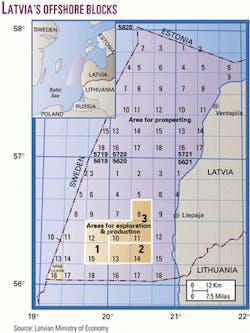Expressions of interest in Latvia's first oil and gas licensing round for exploration acreage in the Baltic Sea have been greater than expected, the Latvian Development Agency said.
The ministry of economy offered seven permits for exploration and drilling and 66 blocks for "preinvestigation." Each block covers 382 sq km.
An unspecified number of companies have visited the agency, and some have acquired seismic and well data, said Leonids Kvaskovs, vice chairman of the Latvian Licensing Commission in Riga.
Preinvestigation licenses must be applied for by Oct. 31, 2001, while the deadline for bidders for exploration licenses is Jan. 25, 2002.
The licenses for preinvestigation would be for 2 years, said the ministry, with the potential for the term to be extended by 5 years. E&P permits will be granted for 30 years, inclusive of an up to 5 year exploration phase.
The ministry noted that the Latvian state would retain a 10% stake in all awarded licenses, with the licensees subject to a 25% corporate tax and an oil royalty, based on volumes of oil produced, ranging from 2-12%.
Latvia's state geological survey published an atlas of petroleum potential and exploration opportunities in 1997. It pointed to oil and gas prospectivity in the Baltic syneclise and nonprospectivity in the Latvian saddle, which has shallow, metamorphic basement.
The atlas showed an offshore territory of 27,000 sq km, of which 20,000 sq km is in 100 m of water or less. More than 50 wells have been drilled in the entire Baltic, 35 of which had shows, mostly oil.
Oil and gas status
Latvia has not produced oil or gas commercially. The country has onshore oil and gas pipeline networks and trans-ships large volumes of Russian crude oil and products exports.
Latvia's offshore E6 and E7 wells terminated in Precambrian basement at TDs of 1,095 m and 1,650 m, respectively. The P6 well went to TD 1,835 m and penetrated 300 m of crystalline basement.
The three wells penetrated the Paleozoic succession, Devonian through Cambrian, typical of the offshore sequences. They all contained oil shows, and E6 was a minor oil discovery, the atlas said.
The government hopes to issue the first onshore licenses beginning in 2003. Regulations for onshore licensing are in preparation, Kvaskovs said.
Latvia has several small onshore discoveries. These include Kuldiga, where oil was found in 1963 in Middle Cambrian sandstones, and several small Ordovician finds.
At Kuldiga, on the Kuldiga high 47 miles northeast of Liepaja, oil was tested at about 20 b/d at the R-2 well from Deimena sandstones at a little more than 1,000 m. The Kuldiga oil is 25° gravity, waxy and tarry, with low sulfur content. Porosity was 20-30%, and permeabilities were 350-1,400 md.
Kuldiga was the first oil discovery in the Baltic region's Cambrian succession.
Russian Baltic
Meanwhile, a unit of OAO Lukoil planned to start production from Kravtsovskoye (D-6) oil field on the Russian Baltic shelf off Kaliningrad in 2003.
Lukoil plans to recover 8.85 million tons of oil through 27 wells on a fixed platform in the zero discharge operation. Project capital spending was to total $118 million in 2002-03.
A Lukoil management committee said the unit, OOO Lukoil-Kaliningradmorneft, has studied several development options, acquired 3D seismic data, and nearly completed project cost estimates. It also began creating shore infrastructure for the construction and subsequent operation of oil producing facilities: ice-resistant fixed platform, land and subsea pipelines, and an oil terminal.



